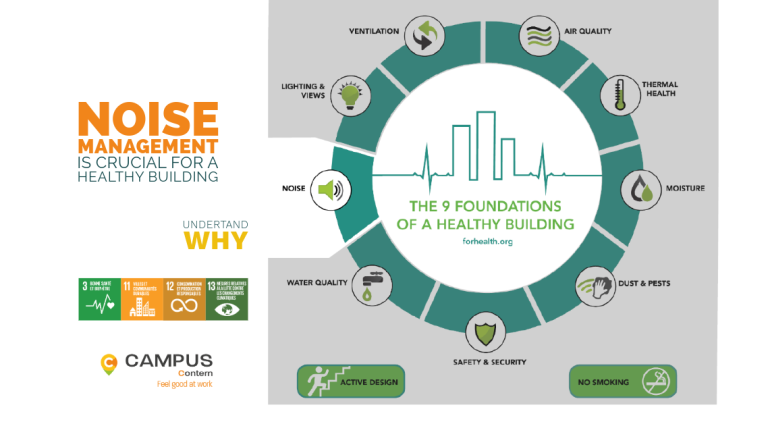Noise, often described as “unwanted or disturbing sound,” impacts our health, well-being, and productivity in buildings where we live, work, and learn.

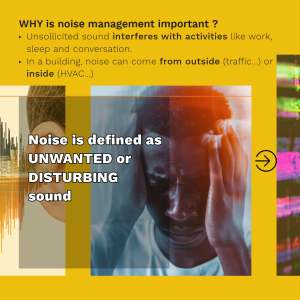
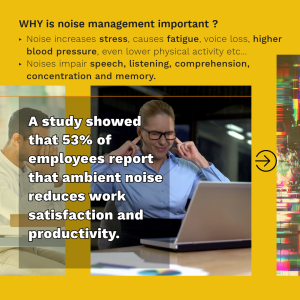
What is noise?
Noise sources range from outdoor traffic, aircraft, and construction, to indoor mechanical systems and occupant conversations. While most people are aware that loud noise can cause hearing loss, exposure to moderate but persistent noise (above 55 dBA) can also contribute to chronic health issues.
For instance, an estimated 145.5 million Americans are regularly exposed to noise levels linked to an increased risk of hypertension.
How does noise affect our health?
Health impacts from noise exposure extend beyond hearing.
Noise can disrupt normal bodily functions, increasing blood pressure, altering heart rates, and triggering stress responses by elevating stress hormones like adrenaline.
Among children, exposure to environmental noise has been associated with behavioral issues, higher stress levels, and even impaired cognitive performance in school. The impact on children’s learning is particularly concerning: studies have shown that noise from sources like nearby aircraft can lower children’s reading comprehension, memory, and concentration, hindering their overall development.
For adults, nighttime noise can disrupt sleep, which in turn raises the risk of cardiovascular issues; daytime noise, especially from road traffic, has been linked to higher mortality from hypertension and an increased risk of diabetes and obesity.
Noise in workplaces is also a significant concern. In open-plan offices, ambient noise can distract employees, impacting their performance and job satisfaction.
More than 53% of employees report that background noise diminishes their productivity, highlighting the need for effective noise management in modern office designs.
What can we do?
To reduce noise exposure, building design and layout improvements, soundproofing measures, and effective insulation can help manage noise levels.
Implementing quiet HVAC systems and optimizing acoustic design.
Creating designated quiet zones can significantly enhance well-being, productivity, and learning outcomes, making buildings healthier spaces for all occupants.
@CAMPUS CONTERN it means :
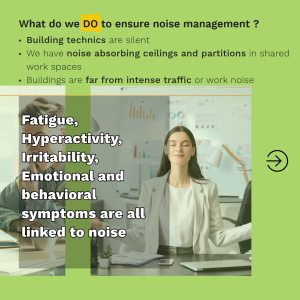
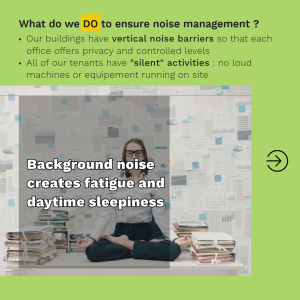
- Each of our buildings are equipped with quiet HVAC
- All floors are ready for acoustic partitions : every office has an acoustic barrier to ensure privacy and reduction of ambient noise
- Our buildings are away from high traffic or work areas, ensuring quiet surroundings
- All of our shared working spaces have additional noise absorption ceilings or partitions, to minimize the potential nuisance of large common spaces
- All tenants have “silent activities” with no noisy machines or equipment.
Our Goal :
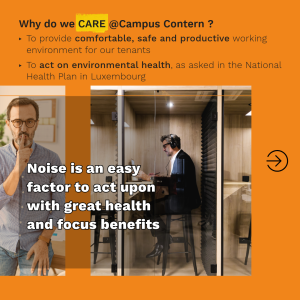
- To make sure that our tenants have a safe and healthy work environment. They spend a lot of time in our buildings, it is our responsibility to do our best to reduce the causes of fatigue, absenteeism and to foster concentration and performance
- To protect our tenants from chronicle diseases and play our part in the National Health Plan
Source : “The 9 foundations of a healthy building” Harvard School of Public Health – forhealth.org
